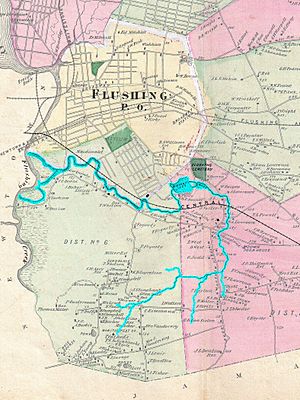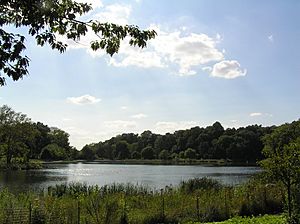Kissena Creek facts for kids
Kissena Creek is a stream that mostly flows underground today. It runs through parts of Flushing, Fresh Meadows, Hillcrest, and Kew Gardens Hills in the New York City borough of Queens. The creek starts in what used to be a swamp in Kew Gardens Hills and Pomonok. It then flows east to Hillcrest.
After that, Kissena Creek generally flows north and west. It goes under the Kissena Park Golf Course, Kissena Park, Kissena Corridor Park, and the Queens Botanical Garden. Finally, it joins the Flushing River in Flushing Meadows–Corona Park. The name "Kissena" comes from the Chippewa language. It means "it is cold," "cold place," or "cool water." Most of the creek was covered up or sent into sewers in the 1900s. The only part of the creek you can still see above ground is Kissena Lake in Kissena Park.
Contents
Where Kissena Creek Begins
The creek, also known as Mill Creek or Ireland Mill Creek, started in a large swamp. This swamp was located in the areas we now call Kew Gardens Hills and Pomonok. People called this swamp by different names, like "Peat Bog Swamp" or "Old Crow Swamp."
This swamp was about 140 acres (57 hectares) in size. It was bordered by Vleigh Place to the west and Kissena Boulevard and Parsons Boulevard to the east. When Parsons and Kissena Boulevards were first built, they curved around the swamp. This curve was later called "Dead Man's Bend" because of many car accidents. Eventually, a new road was built to make it safer.
In the late 1800s, people used the swamp to get peat. Peat is a type of fuel that forms from old, decayed plants. As Kew Gardens Hills grew, the swamp got smaller. Streets were built right on top of it. By 1918, the swamp was almost completely drained. Today, Lander College for Men and Opal Apartments are built where the swamp used to be.
Kissena Creek in Fresh Meadows
After leaving the swamp, the creek flowed east, next to where 72nd Avenue is today. It then turned north in the area now known as Fresh Meadows. This is near Francis Lewis High School. The creek then flowed alongside what is now Utopia Parkway. It continued to the Kissena Park Golf Course, which is just south of Flushing Cemetery.
The creek ran under Fresh Meadow Lane, which is on the east side of the golf course. Then, it turned west and flowed under the northern part of the golf course. A smaller stream used to flow north from a kettle pond in Utopia Playground. This stream joined the main creek at Utopia Parkway. The kettle pond was filled in during 1941.
Kissena Park and Kissena Lake
The creek then turns west and flows into Kissena Lake. This lake is in the northwest part of Kissena Park. Kissena Lake gets its water from the creek. It also used to get water from a smaller stream to the north, but that stream is now buried. There is a playground built on top of it. In the middle of the lake, there is an island for birds. This island was built after the lake was cleaned up in 2003.
The name of the lake, park, and creek all come from the Chippewa language. It means "it is cold," "cold place," or "cool water." The area where Flushing Meadows–Corona Park is now, just west of Kissena Park, was once part of the Hudson River's path. Kissena Lake was on the eastern shore of that ancient river.
A huge glacier once covered much of Long Island, where Queens is located. As the glacier melted, it left behind dips in the land. Some of these dips, like Kissena Lake, filled with water. In the 1800s, people used the lake for ice skating and for harvesting ice. Because people enjoyed the lake so much, the city bought the land around it in 1906 to create a park. The glacier also created a natural source of well water for the area.
Originally, the west side of Kissena Lake flowed into the creek. There was a bridge over it, like the Central Park's Gapstow Bridge. In 1942, Kissena Lake was dredged, which means its bottom was cleaned out. This was part of a project by the Works Progress Administration. This project changed Kissena Lake into a "bathtub lake" with concrete edges. Before this, the lake was part of a wetland. In the 1900s, people thought wetlands were not very useful.
Because the lake had no natural air flow and was warmed by its shallow depth and concrete edges, a lot of algae grew. This meant the lake needed another cleanup in 1983. In 2003, a $2.3 million project drained the lake in stages. This gave it its current look. The city water was replaced with well water, and an aeration system was put in to add air to the water. The concrete edges were replaced with natural materials like rocks and plants. A small island was also built in the lake for birds and turtles.
Kissena Corridor Park and Sewers
Underneath Kissena Park and the western part of Kissena Corridor Park is the Kissena Corridor Sewer. This is a combined sewer, which means it carries both rainwater and wastewater. It collects water from as far east as Little Neck, near the border of New York City and Nassau County.
This sewer was built along the path of Kissena Creek. The creek was slowly sent into the sewer during the mid-1900s. For example, in 1934, the creek was put into a culvert (an underground pipe) where it crossed Main Street. This was done to make the street wider.
The Kissena Corridor project started in the 1930s. The idea was to create a green space to connect several parks in eastern Queens. This project also included building a large storm sewer through the corridor. Officials said this sewer was needed because of how much water collected in this natural drainage area.
In 1942, the federal War Production Board stopped the building of the Corridor Sewer. This was because steel was needed for World War II. Work on the sewer project finally began on April 1, 1947. The main part of the Corridor Sewer was finished by September 1948.
The western part of Kissena Corridor Park was filled with dirt in the 1950s. This dirt came from digging out land for the Long Island Expressway. Before this filling, the creek could still be seen in the western part of the park. It sometimes caused flooding in nearby neighborhoods. By 1960, a lot of dirt was put into the park from the Long Island Expressway project.
Queens Botanical Garden and the Creek's End
The sewers from Kissena Corridor Park flow west through the Queens Botanical Garden. From there, the sewers go under College Point Boulevard. They then enter the Flushing Bay Combined Sewer Outfall (CSO) Retention Facility. This facility is located in Flushing Meadows, under the Al Oerter Recreation Center.
This facility can hold a lot of water from overflows during storms. It can hold up to 43.4 million US gallons (164 million liters) of water. After holding the water, it pumps it to the Tallman Island Waste Water Treatment Plant in College Point. If there's no overflow, the water empties into the Flushing River (also known as Flushing Creek). The Flushing River then flows north into Flushing Bay, which is part of the East River. The East River is an arm of the Atlantic Ocean.
Before the 1964−1965 New York World's Fair, the western part of Kissena Corridor Park was used for the World's Fair. This area was next to Flushing Meadows Park. In 1961, the Queens Botanical Garden was planned to move from the fairgrounds to the west end of Kissena Corridor Park. This new site was originally going to be a parking lot for the fair. Instead, the Queens Botanical Garden was built there. It was officially opened on October 19, 1963.
The Queens Botanical Garden has a plan from 2001 to create a self-sustaining ecosystem. This plan includes a stream that forms from rainwater collected on the roof of its main building. This stream flows through pools towards a wetland at the garden's western edge. Water collected from the garden's parking lot also adds to this stream. Part of this new stream follows the original path of Kissena Creek.



